Editor of this issue: V. Stanley Vardys
Copyright © 1979 LITUANUS Foundation, Inc.
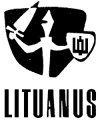
|
LITUANUS
LITHUANIAN QUARTERLY JOURNAL OF ARTS AND SCIENCES
Volume 25, No.2 - Summer 1979
Editor of this issue: V. Stanley Vardys ISSN 0024-5089
Copyright © 1979 LITUANUS Foundation, Inc. |

|
GRAPHIC ART OF VACLOVAS RATAS
GENOVAITĖ KAZOKAS
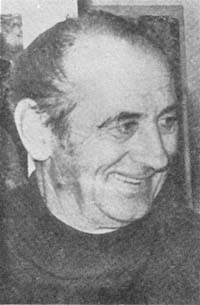 An outstanding artist, Vaclovas Ratas (1910-1973) significantly contributed to the development of Lithuanian graphic art.
An outstanding artist, Vaclovas Ratas (1910-1973) significantly contributed to the development of Lithuanian graphic art.
In 1937, at the International Graphic Art Exhibition in Paris, he was awarded the prix d'honeur for his woodcut illustrations of Jūratė ir Kastytis. In 1946, he established his own Art School in Augsburg, Germany, where he edited 40 Woodcuts, the first Lithuanian art book in exile. In Germany, furthermore, for five years he worked as art editor of the Augsburg Lithuanian weekly Žiburiai (The Lights). In Australia, he became a founding member of the Sydney Printmakers Society in 1961, edited Eleven Lithuanian Artists in Australia in 1967, and played an important role in promoting graphic arts in the subcontinent. In 1965, Ratas received the silver medal from the Australian Fashion Fabric Design Awards.
Ratas' work underwent a great metamorphosis from linear graphic illustrations to the blocky German period, then to fantastically ephemeral monotypes. He was the first and until now the only one who has enriched the Lithuanian graphic art with the use of color subtlety of the Japanese masters. With fragile lines and the delicate tonal modulation of color he created masterpieces which earn him the most prominent position in the history of Lithuanian graphic art history.
Vaclovas Ratas was born on the 25th of February, 1910, in the Southern Lithuanian village of Paliepis, located in the area of Seinai. He inherited the drawing ability from his father who often fascinated his children by drawing running and jumping horses.
In 1930, Ratas entered the Art School in Kaunas, Lithuania. The graphic art class at the school was under the direction of Professor Adomas Galdikas (1893-1969), an extraordinary man of unbelievable vitality and enthusiasm. His magnetic personality attracted the most talented students of that time. Galdikas presented graphic art in a glamorous light, appealing also to the students' patriotic and pioneering spirit. Vaclovas Ratas, a reserved and withdrawn personality, was attracted by his professor's enthusiasm and sought to achieve many of his teacher's goals.
To a young provincial lad of twenty, the Art School in Kaunas seemed like a bustling center of life kept whirling by numerous artistic and political groups, which ranged from the radical to conservative. In 1931, Ratas became one of the founding members of FORMA, a group of seven members including Paulius Augius, Viktoras Petravičius, Telesforas Valius, Antanas Kučas, K. Šaulys and H. Rudzinskas. They declared political neutrality and devoted themselves to the formal values of art. This group of young artists endeavored to give graphic art a modern form, deriving its roots, however, from Lithuanian folk-art. To symbolize the unity of the youthful seven, the young artists wore widebrimmed hats and silver rings with the sevenleaf clover emblem. It so happened that later in life the first four members of the group developed a brotherhood lasting during their lifetime. Only V. Petravičius is still living. The group included the most significant representatives of Lithuanian graphic art of that period.
In 1936, after graduation from the Art School the previous year, Ratas continued studying in the galleries and museums of Berlin, Rome, Florence and Venice.
During the next nine years he took part in numerous art exhibitions at home and abroad, for example, Latvia, Estonia, Czechoslovakia, Germany, and the United States. In 1937, forthermore, he became curator in the Vytautas the Great Museum, Kaunas.
THREE PERIODS OF ARTISTIC LIFE
Vaclovas Ratas' artistic activity is divisible into three main periods: 1. Lithuanian period, 1933-1934; 2. Exile in Germany, 1945-1949; and 3. Australian period, 1950-1973.
Despite differences in style and technique, there is something which unifies all his works, namely the same basic approach of simplicity, sincerity and love of decorative values. The works of his Lithuanian period are purely linear in conception. His illustration Seku seku pasaką (Tell tell a fairy-tale) for V. Krėvė's book, 1933, exhibits the joyful and youthful spirit. The line is used only as a means of contour and the abundance of decorativeness within it enhances the happiness of a childhood.
The famous cycle of woodcuts Jūratė and Kastytis, 1936 (tale of an unhappy love affair between a mermaid and a fisherman), is rendered in clear straight lines and simple composition. The relationship of black and white is carefully balanced and results in unmistakable clarity of vision as in Mother. The unadorned block line is even and calm all the way through. The print depicting the amber palace has highlighted the decorative element and in Grief of Jūratė (the mermaid) the broader planes appear next to the lines suggesting some movement and unrest. Although he illustrated a dramatic event, the unhappy love of the sea-goddess Jūratė, Ratas remained in the realm of fantasy and refused to be involved in the drama, always maintaining a certain detachment. These characteristics give the illustrations a fairy-tale quality of lightness and playfulness. These woodcuts were executed on crossgrained sandalwood; they were of the same dimensions (10 x 10 cm) and all prints were made on Japanese rice paper.
During this period Ratas created several single woodcuts portraying the local landscapes such as Panemunė, 1938, and Kretkampis, 1939 (localities on the river Nemunas), The last work of the Lithuanian period is Fishing net, 1939. Here one can see the future Ratas: static, decorative, deliberately simple, singling out one ordinary subject. In this print the artist demonstrates his feeling for the line: simple, even, unadorned and calm.
During the war, in the summer and autumn of 1944, about 80,000 Lithuanians left for the West seeking refuge from the returning Soviet armies. Ratas and his beautiful wife, the ballet dancer Regina Drazdauskaitė, found themselves in Augsburg, Western Germany. The short German period (1944-1949) commences with a woodcut At the Crossroads, 1946. Ratas was evidently overcome by nostalgia as the roadcross with the Sorrowful Christ is a symbol of Lithuania. His memories of the war were fresh and for the first and only time Ratas represented the immediate realities: burning villages, running refugees and the general unrest in the landscape. His style lost the linear calm and confidence. Now he introduced the black blots, broke the simple line and inserted numerous fine crisscrossing strokes to arouse the feeling of calamity.
In the next cycle of nine woodcuts, The Ravens, 1948, Ratas approached the German expressionists. He used the powerful optical effects of stiff angular images and aggressive sharp broken lines. The vigor and animation of the whole surface gave the illustrations a sombre, agitated mood. In these nine woodcuts the broad black planes dominate over the disquiet, unruly lines. With an unusual force the artist fractured the large planes, contrasted them at different angles and emphasized their crudeness with wide, white borders. The title illustration depicting two large gloomy ravens is a sure and definite pictorial statement, a strong tight composition. These factors give a certain grandeur to the little woodcut.
In March of 1949, the Lithuanian Institute of Arts, of which Vaclovas Ratas was a member, organized the last large retrospective Lithuanian Art Exhibition in Augustiner Museum, Freiburg. The graphic section was extremely strong. Apart from the four members of FORMA, the museum exhibited works by Professor Vytautas Jonynas, Adolfas Vaičaitis and Viktoras Simas. Jonynas now lives in New York, Vaičaitis and Simas in Melbourne, Australia.
The Lithuanian press was enthusiastic and depressed at the same time as it saw the end of the first historical period in exile. The refugees faced emigration to countries of permanent residence which meant a dispersal of their intellectual and cultural activities throughout the world. The majority of Lithuanians emigrated to the U. S. A., Canada, and South Australia. A group of ten thousand settled in Australia.
In 1949, Ratas, his wife and their daughter Ramoną arrived in Fremantle, Western Australia. To be admitted to Australia, all immigrants, regardless of their occupation, had to sign a two-year work contract with the Commonwealth. Ratas was immediately assigned to work in a metal works factory, later in a brick factory and finally transferred to a construction site as a construction worker. Physical exhaustion and the cultural vacuum the refugees found on arrival pushed Ratas into a deep depression. He lost interest in life and became disillusioned with the whole world. Fortunately, he met George Voudouris, an artist of Greek origin, who had already acclimatized to Australia. Voudouris arranged formalities with the Employment Office concerning Ratas' two-year contract and brought him to Perth. Here at last Ratas was given a job in a pottery workshop, Scarborough.
The artist's Australian period is the longest, most varied and at times very prolific. Ratas' conception of art led him to what he thought were the primary sources of creativity, namely, folk mythology and legends. This attracted him to Australian aboriginal art. Ratas was intrigued by aborigine fairy-tales and the visual representation of their fantastic world. In 1952-53, the artist experimented with aborigine themes, introducing many native symbols in the following works: Kangaroo Hunt, Fish, Emu, Mimi. In 1953, Ratas exhibited twenty-two woodcuts in the Newspaper House Art Gallery, Perth. The gloom of his works of the German period had disappeared. His rendering became again predominantly linear with even more fluency and precision. In the small woodcuts, e. g. Ths Swans, Kookaburra, Composition, Black Boy Ratas reached astonishing heights of craftsmanship and artistic flare. His unadorned, even line became graceful and melodious. The rhythmicity of his compositions bestowed the works with the quality of musicality. To his previous decorativeness Ratas added elegance and gracefulness. The tonal gradation became very subtle. These are mature and sophisticated works presented in an apparently simple and gay, decorative manner. In his larger woodcuts, e. g. Esplanade, Ferry Boat, Landscape, Scarborough Bus, depicting local scenes, Ratas is more placid; these works lack the melodious flow of lines and rhythmicity in composition although they are executed with professional attention.
In spite of two combined exhibitions with Voudouris and several lectures and demonstrations on graphic arts, Ratas' ambition of reviving and popularizing this type of art failed. He saw no artistic future in Perth. The people, though wealthy, valued other commodities much more highly than works of art.
In 1954, Ratas' family went to Sydney. He immediately joined the Lithuanian artists' group called Aitvaras (The Goblin), established in 1950. The president was Jurgis Bistrickas and the vice-president Henry Šalkauskas. All the Lithuanian artists of Sydney belonged to this groupAlgis Šimkūnas (1927-1970), Vladas Meškėnas, Jurgis Mikševičius, Juozas Kalgovas, Vincas Stanevičius, Petras Repšys and Viktoras Simas. Ratas found this group as well as the more cosmopolitan artistic atmosphere of the city stimulating and alarming. Ratas was older than the others and the only artist from this group who had recognition both at home and abroad. He had firm ideas about art, conceived in school and later developed in exile, and found them seriously challenged. He lost what he considered the roots of inspiration: the tradition of folk-art. Secondly, up to this time Ratas worked mainly as a book illustrator and as such was provided with subject matter. In addition, his health began to deteriorate and he found woodcutting physically difficult to handle. He needed a new medium. In 1956, Ratas arranged his first exhibition in Bissietta Gallery, Sydney. He showed thirty woodcuts, all earlier works. Apparently Ratas needed time to solve his creative and personal problems.
The Sidney period of 1954-60 is the most unproductive in all his life. Sydney's artistic scene was dominated by abstract art, and nearly all new-comers moved on its waves. Ratas was familiar with the rise of abstract expressionism in Europe. Formal elements were for him always of the utmost importance. It seems, however, that the medium of book illustration, as well as his restrained and disciplined personality, prevented him from breaking the acquired mode of expression. Of personal health necessity, nevertheless, he had to abandon the woodblock; this left linocut and plaster as the nearest techniques. The lino offered a much softer rendering of line and a greater variety of background tonality. The medium of plaster brought out in the artist a certain amount of sponaneity and breadth. Also, up to now he had been a master in the black and white small print. In the abstract expressionist Australian exhibitions which usually were rich in the use of color, the public passed over in silence Ratas' heavy black blocks as if they were a "memento mori" (reminders of death). These thoughts must have turned in his head for some time, as in about 1960, Ratas emerged new, fresh and colorful.
The artist's encounter with color became apparent in his first linocut of the Sydney period. He commenced by applying color to an entire plane. The first colored linocut was Barrier Reef Fish, 1960, where his stylization and decorativeness are woven into a single colorful and static image. However, soon he discovered the possibilities of texture variations offered by the grain in wood, which provided for color modulations. Condensation of the pigments, reinforced by the nature of wood grooves, presented immense possibilities for a multitude of subtle hue changes. Later Ratas reached the summit of his delicate color refinement in his glass monotypes, in which the subtlety of soft hues attained an ephemeral quality.
Beginning with the linocuts Ratas created color prints on a bigger scale. His Sonata, 1962, is a print in five colors. It is a quiet, dignified frozen music. Similar in feeling is his October in N. S. W., 1964.
The technique of plaster cutting brought out in him freer and more abstract line and curve arrangements. In some, e. g. Sunny Days and Formation, there is exuberance, fresh vigor and, indeed, new spontaneity.
From 1965 Ratas began to work on metal, sometimes using it for engravings, e.g., The North Pole, Frozen Sun, Desert, sometimes as collage, e.g., Fragments in Space. He also made relief (never intaglio) from them. These are abstract works of larger dimensions (60 x 90 cm) evoking some mysterious fantasies. With assemblages of metal scraps, e.g., Luxurious Space, he acquired a new exciting crusty texture.
Very sober, clear and free from any mysterious connotations are his constructed metal collages Black and Grey and Building, from which he made prints. Ratas represented Australia in the First British International Print Biennale in Bradford, 1969, with Black and Grey which was reproduced in the catalogue.
Some primordial elements emerge in his Creature, 1965 (mixed media). Now his simplified rendering is a far cry from the naivete of folk-art. Ratas lost his traditional flavor and became a cosmopolitan. He also abandoned abstract expressionism and started again to concentrate on a single figurative motive. However, from time to time he returned to legend, e. g. Korunokadju, 1968, where he depicted a monstrous aboriginal wolf demanding human sacrifice. In this extremely elegant metal collage the bold yet graceful figure stands out in contrast to the subtle nuances of the background foil, faintly tinted in barely perceptible changing hues in a search for textural animation, his Sydney experiments with metal graphics or metal collages were influenced by Tapies, Bissiere and Jaemish.
LAST YEARS OF RATAS' LIFE
From about 1967 Ratas was under constant medical supervision for leukemia. However, he was not aware of the true diagnosis and after blood transfusions felt himself quite well, even if for a short time. Ratas always talked about the woodcut with great longing. Whether this was a longing for the medium only or a longing for his lost strength and his past youth is an open question. For the last time he tried his hand in woodcut with Lagoon Bird, 1967. With the polished ease and restraint the artist depicted in the three-colored print (black, white and royal blue) the humble yet eloquent little bird. The accentuation of a single element of a pictorial statement through simplifying form and leaving out details resulted in admirable aesthetics bordering on asceticism. Color modulations on the wood grain give the work slightly transcendental characteristics.
By 1970 Ratas was mainly confined to bed. On warm days he laid in a deck-chair in his backyard and between naps fed the birds. When he felt stronger, he drew his companions with great mastery and gentleness. By this time the artist was using very complicated mixed glass technique, employing some knowledge of Japanese water-based color pigments, unknown to Western printmakers. His birds are like refined ballet dancers on the stage. In his monotypes from glass or mixed media he developed a rare sensitivity to passages of tonal gradations which together with the crisp rhythmical lines endowed the pictures with a high degree of musicality. Contrary to common belief, the process of printing a monotype is long and tedious, often requiring a whole day's work. The extreme delicacy of Ratas' monotypes sometimes was due to gently variegated chromatic hues, sometimes to harmonious blending of the colors' nuances. Ratas made the viewer conscious of the depths of insinuation of the intimate color scale. His monotypes acquired ephemeral coloristic effects inaccessible to paintings.
His last two years of artistic activity are crowned with the creation of monotypes of birds. It is regrettable that in the black and white reproductions there vanishes the subtlety of his color nuances.
In 1972, Ratas sent his three works to the Lithuanian Art Exhibition during the traditional Lithuanian Festival in Sydney. The works were returned to his widow; he died on March 1, 1973, in the arms of his devoted wife.
He was one of those artists whose personality was fully and sincerely reflected in his works. In life, he was an extremely elegant man. He appreciated beautiful things, was an unassuming, hard working and disciplined person with a great sense of duty. His studio was as tidy as a surgery room, every chisel in its proper place. Music and ballet were part of his everyday life. He worked intensely and regularly. In his works there is no place for accident, chance or subconsciousness. Everything is deliberate and well thought out in advance.
During his school days he admired Duerer, later Picasso and Matisse. The attraction to them must have been mainly spiritual. Duerer probably impressed him with his precision, Picasso with the urge to experiment, and Matisse with the joyful approach to art and life. Ratas was not concerned with high philosophies. He was devoted to the beautiful detail, inclined to single out one particular from the broad context.
Ratas' art is devoid of any troubling subject matter. He created a graceful, refined and joyful world, desiring to please and delight.
Vaclovas Ratas is represented in Vytautas the Great Museum in Kaunas, art museums in Vilnius, Telšiai and Šiauliai (all museums in Lithuania), the National Art Gallery of NSW, Sydney, Western Australian Art Gallery, Perth, Newcastle Art Gallery, and numerous private collections.
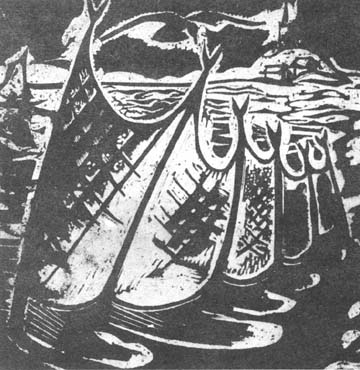
Fishing Net, 1939, Kaunas Woodcut 14 x 14 cm
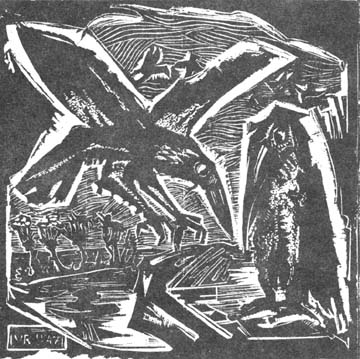
The Ravens
Illustration from The Twelve Ravens
Woodcut 12.5 x 12.5 cm, 1948, Augsburg, W. Germany
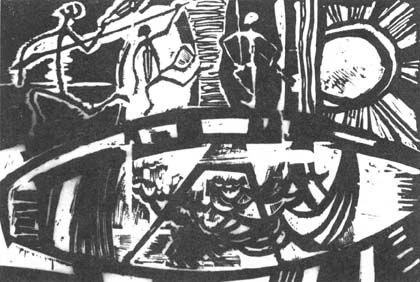
Mimi, Woodcut 12.5 x 18.5 cm
1952, Perth, Australia
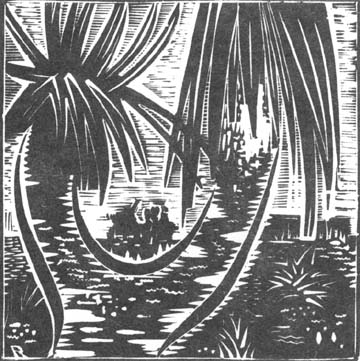
Black Boy,
Woodcut 13 x 13 cm
1953, Perth, Australia
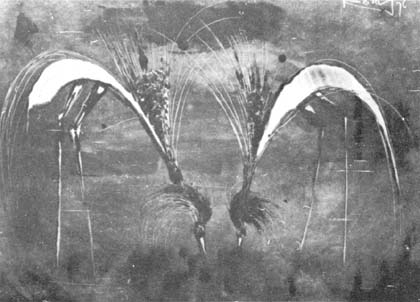
Birds, Monoprint
1972, Sidney, Australia
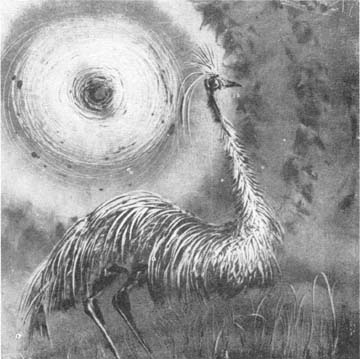
Emu,
Monoprint 48 x 48 cm
1970, Sidney, Australia
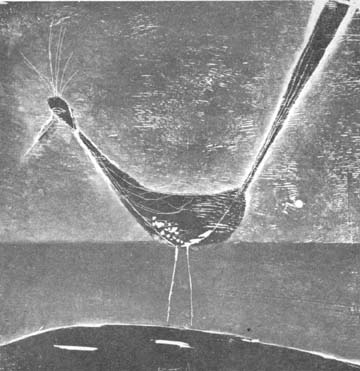
Lagoon Bird,
colored wood 48 x 48 cm
1967, Sidney, Australia,
In National Art Gallery of NSW, Australia
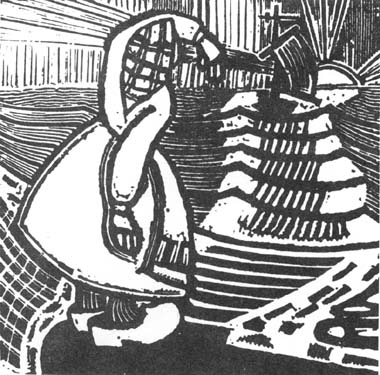
Mother, From the cycle Jūratė and Kastytis
Woodcut 10 x 10 cm, 1936, Kaunas, Lithuania